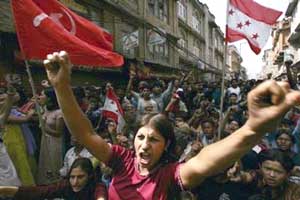Untitled Document
 |
|
Katmandu, Nepal, April 11.
|
Popular forces in Nepal have stepped up their campaign to overthrow
the government of King Gyanendra and end the monarchy. The revolutionary forces,
led by the Communist Party of Nepal (Maoist) [CPN(M)], and the opposition parties
launched a new wave of coordinated resistance and protest.
A four-day general strike began April 6, called by the opposition parties—a
coalition of seven parties that oppose the king—and backed by the revolutionary
forces. The CPN(M) and opposition parties reached a 12-point agreement in late
December that calls for allied actions to end autocratic monarchy and bring about
fair elections to a constituent assembly. The demonstrations have been called
to challenge Gyanendra’s assumption of dictatorial powers 14 months ago.
Gyanendra’s forces quickly moved to violently quell the demonstrations,
even though the CPN(M) initially declared a ceasefire in Nepal’s capital,
Katmandu, to ensure that its activities would not be used as an excuse for the
government to violate the rights of the protesting people.
Plainclothes police officers had arrested hundreds of political leaders before
the strike began. Over 400 additional people were detained on the first day
of the strike. The Royal Nepalese Army (RNA) and police forces have turned to
increasingly violent measures as thousands of workers, students and professionals
poured into the streets in defiance of the government’s daytime curfew.
Government forces repeatedly fired on protesters, leaving four dead and dozens
seriously injured. In Bharatpur, police shot dead a woman who was simply observing
the protests from the balcony of her home. A protester in Banepa was killed
when police fired on a crowd demonstrating against an earlier killing.
The United Nations Human Rights Office in Nepal has criticized the government
and expressed “grave concern” over its violent tactics. Even the
U.S. and British imperialists, who want a stable government in order to more
effectively beat back the revolutionary forces, are now publicly distancing
themselves from the king.
Meanwhile, the government has threatened to get “stricter” with
the protesters by imposing extended curfews and granting its police forces shoot-to-kill
orders.
Protesters fight back
The demonstrations have grown more militant as protesters attempt to protect
themselves from violence at the hands of the RNA and police. “Burn the
crown” is the new slogan in Katmandu.
Protesters have taken to setting up barricades of burning tires and throwing
bricks when the police attempt to charge the crowds with batons and rubber bullets.
In some areas the demonstrators have expressed their anger by occupying government
offices in protest of the killings.
People stormed a hospital in Pokhara to demand the body of a slain demonstrator.
The opposition party leadership has called for an indefinite extension of the
strike. As one unnamed demonstrator put it, “We are not afraid of bullets.
We have to get democracy at any cost and we will get it.”
CPN(M) intensifies offensive outside Katmandu
The top two leaders of the CPN(M)—Chairman Pranchada and Chief of Foreign
Relations Baburam Bhattari—issued a statement promising that their party’s
armed wing, the People’s Liberation Army (PLA), would take control of
roads throughout the country in support of the general strike and destroy all
royal statues and signs that refer to “His Majesty’s Gov ernment.”
The statement also announced a new campaign to stop businesses from paying taxes
to the royal government.
In solidarity with the struggles in the cities and in defense of the unarmed
protes ters, the revolutionary forces have inten sified the armed offensive
throughout the countryside. On April 6 the PLA launch ed simultaneous attacks
on all government agencies in Malangawa. Over 100 prisoners were freed when
the PLA overran the district prison. A night-vision helicopter sent to reinforce
government troops was reportedly shot down by the PLA.
On April 7 the PLA launched simultaneous attacks on government installations
in Butwal and Kapilvastu, freeing 110 inmates from an area prison. Bombs destroyed
several police posts, RNA barracks and other government buildings. Thousands
of PLA soldiers reportedly participated in the armed actions.
The monarchy’s state apparatus has been severely shaken by the revolutionary
military offensive and the coordinated general strike across the country.
Anger against the government’s use of violence to repress the revolutionary
movement is evident in the massive nature of both the demonstrations and the
revolutionary armed actions.
As Lok Raj Baral, head of the Nepal Center for Contemporary Studies, recentl
y stated, “If the movement goes ahead like this, the inevitable will happen
very soon. The anger everywhere is against the king.”

